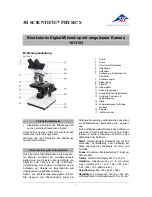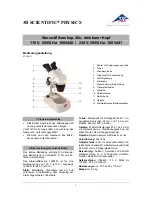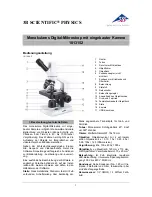
13
Fig. 2
6
Centering the Aperture Iris Diaphragm
(Fig. 2)
1. Close the light path by sliding the shutter knob @ to position marked {.
2. Engage the B or IB mirror unit in the light path by rotating the turret.
(If these mirror units are not available, engage another fluorescence mir-
ror unit in the light path.)
3. Engage the 10X objective in the light path and lace the U-CST centering
target on the stage.
4. Open the light path by sliding the shutter knob to position marked \.
5. Move the white surface with crosslines of the U-CST until the crosslines
are overlaid on the center of field.
6. Turn the revolving nosepiece to engage the empty place (the objective
cap should be removed) in the light path.
7. Pull out the aperture iris diaphragm knob ² to minimize the aperture iris
diameter.
8. Pull out the field iris diaphragm knob ³ to minimize the field iris dia-
phragm. Now the aperture iris image should be visible on the U-CST.
9. Fit the Allen wrench in the two aperture iris centering screws | and
adjust so that the aperture iris image coincides with the crosslines.
Effects of Aperture Iris Diaphragm
The aperture iris diagram helps adjust the brightness of the observed
image and improve the contrast.
To execute normal fluorescence observation, enlarge the aperture iris
diaphragm by pushing in the aperture iris diaphragm knob ².
}If specimen colors tend to fade due to too high excitation light, first use
ND filters to reduce the brightness, and decrease the aperture iris dia-
phragm if the ND filters are not enough.
Do not decrease the aperture iris diaphragm too much. Do not use it as
a substitute to the shutter.
@
²
³
|
Содержание BX-RFA
Страница 2: ......
Страница 11: ...7 Make a photocopy of the observation procedure pages and post it near your microscope...
















































